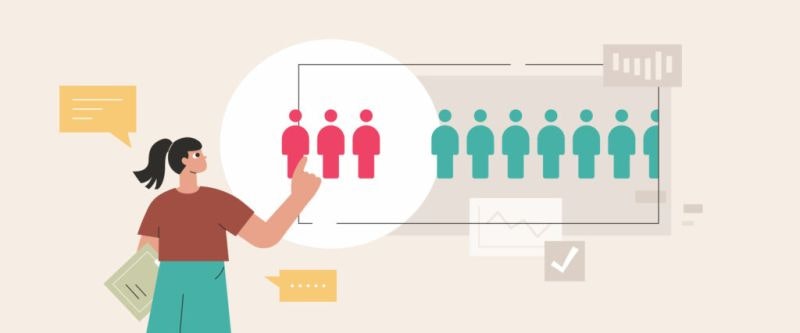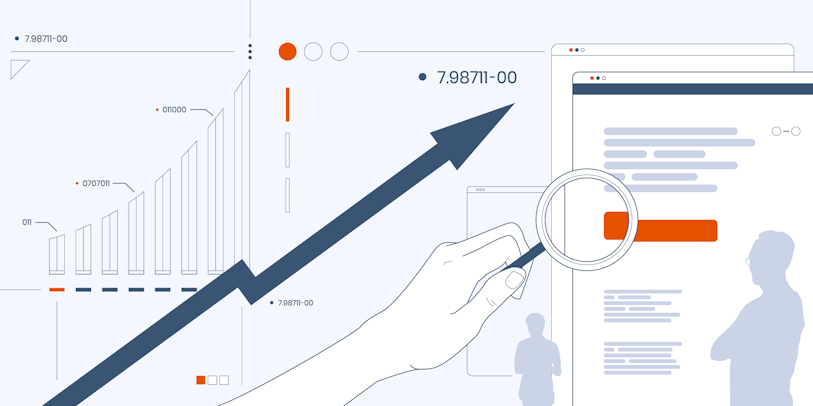SaaS Churn Rate Benchmark
Churn is a key measure of success and stability for SaaS companies. Your churn rates can point out areas where you need to adjust your marketing efforts and rethink your customer retention and onboarding strategies.
With various methods of measuring churn, multiple SaaS metrics to take into account, and various churn rates to assess, you might wonder where to begin. How can you tell if your SaaS churn rate is "good"? What are the most helpful SaaS churn rate benchmarks out there?
We'll cover:
The meaning of SaaS churn
How to determine your SaaS churn
The most important churn benchmarks for your business and market
After reading this, you'll be ready to ask the right questions about your annual SaaS marketing report's churn rate and plan your churn prevention strategies for the next year.
Top Factors That Can influence Your B2B SaaS Churn Rate

Several factors can impact your churn rate and calculations’ accuracy.
These factors include having a small customer base and differences in contract renewal timelines. To assess whether your churn rate is within an acceptable range, consider:
Your target customer or ideal customer profile (ICP)
Whether your SaaS is a startup with a MVP or an established business that has achieved product-market fit (PMF)
Average Churn Rates for SaaS Companies
The average churn rate is often linked to the "stickiness" of your SaaS product. Many experts relate this to revenue, which gives insight into company size. While it's not a perfect measure, it provides a helpful estimate.
Early-stage startups typically churn approximately 10 percent of revenue, with figures between 15-20% being common for some businesses.
You might think that's good, but these numbers are for every month.
At around 10%, you'd have completely new users every 10 months.
In reality, you're likely churning lower revenue clients and keeping higher revenue ones. A good target churn rate is 2%. For large scale solutions with over $10,000-12,000 ARR, aim even lower.
Let's look at churn rates according to company size so that you can understand your B2B SaaS company's numbers.
SaaS Churn Benchmarks : Small to Medium-Sized Businesses
SMBs or Small to medium-sized businesses typically see monthly churn rates between 3% and 7%. Annually, this translates to 36% to around 76%.
Reasons why SaaS SMBs have a high churn rate?
SMB business models usually have an environment that encourages customer churn, particularly before achieving product-market fit. Businesses buying from SMBs often do so in a cheap price range, leading to lower switching costs:
Monthly billing or short contracts make it easier to leave
Cash flow issues can cause frequent cancellations
Low ACV or annual contract value makes switching between products simple
SaaS Churn Rate Benchmarks For Enterprise
For enterprise companies with products priced in thousands of dollars, generally have a very low churn rate. It can be as low as 1 percent.
Higher-priced SaaS products are less likely to see customer switches due to implementation, switching, and training costs. This assumes you're a well established SaaS business. Startups should expect slightly higher churn rates.
Reasons why larger enterprise businesses have a low churn rate?
Enterprise SaaS companies often target larger customers, impacting churn due to:
Larger companies having bigger budgets
More annual billing and longer contracts, making it harder to leave
Higher ACV leading to longer-term commitments
What Makes a Good Churn Rate for a SaaS Company?
A 5% annual churn rate is often seen as sustainable or ideal for SaaS businesses. However, acceptable rates can differ based on company size, type of SaaS product and market.
Annual Churn Rate For SaaS Companies
A good annual churn rate for SaaS businesses is around 5%. This means you keep 95% of your customers each year.
Monthly Churn Rate For SaaS Companies
For monthly churn, aim for less than 1%, which adds up to approximately 12% annually. Larger companies and enterprises typically see lower rates, around 0.5-1% monthly. SMBs might experience higher rates, between 3 and 7% monthly, mainly because of shorter subscription cycles and different customer dynamics.
Industry Differences
Churn rates can also differ widely by industry and SaaS product type. B2B SaaS companies often have a lower churn rate than B2C SaaS companies. This is because B2B relationships tend to be more integrated into client processes and longer-term.
B2B SaaS Churn Rate Benchmarks and Challenges

In today's uncertain economy, understanding the right reasons behind customer churn is crucial for every business. B2B SaaS companies face several benchmarks and challenges. Let's explore why they happen and how to address them.
Churn occurs when businesses don't understand user behavior patterns
When it comes to tracking your users' attitudes, preferences, attitudes, and their ability to pay, personalization is key. Take Amazon as an example. They use extensive data on history of purchase decisions in order to estimate what users will pay for certain products.
Their advanced analytics examine past purchase motivations, including buying history, demographics, and monetary factors like purchase value and shopping expenditure. These metrics help predict the likelihood of new purchases. By understanding your users, you can set accurate pricing plans. This prevents users from feeling overcharged and canceling subscriptions to join competitors offering lower prices.
What do your customers really want?
Personalization matters because it benefits businesses and meets user expectations. Studies show that over 70% of customers find mass marketing frustrating. Many businesses have seen a sharp decline in the effectiveness of birthday mailings, newsletters, and generic campaigns.
User expectations are rising as they encounter more personalized marketing campaigns through channels like digital media.
Focussinguser behavior patterns can significantly improve your customer retention efforts.
How to Track User Behavior Patterns Successfully

A successful, scalable approach to measuring user behavior revolves around three key elements: data, triggers, and methods.
1. Collecting the Right Data (Not Just More Data)
A recent survey revealed that 67% of respondents struggle to use the right tools to access meaningful data. Getting accurate data is essential to understanding user behavior patterns, but it can be tricky. One common challenge is pinpointing gaps and inconsistencies in user data that lead to SaaS churn. By solving this, you can gain insights and tailor your product promotion campaigns effectively.
2. Identifying the Right Triggers for Effective User Engagement
Timing is crucial when reaching out to users. It requires identifying and testing specific events that are relevant to each user, a strategy often referred to as trigger-based marketing in B2B SaaS.
Examples of trigger models include actions like visiting online stores or webpages, searching for price comparisons, or clicking on FAQs to find better solutions.
3. Employing the Right Methods and Technology to Scale
Many B2B SaaS companies get stuck in pilot phases, running successful small campaigns but struggling to expand them. To scale effectively, they need to:
Keep their data updated in real-time and automate processes
Maintain a strong, reliable system infrastructure
Create more interfaces for different sales channels
Additional B2B SaaS Benchmarks
1. Sales and Marketing Benchmarks:
Sales spending has decreased to 10.5 percent of ARR, down from 15% the year before.
Marketing spending now accounts for 8 percent of ARR, a drop from the previous 10%.
2. Research and Development (R&D) Benchmarks:
R&D now represents 18 percent of ARR, down from 24 percent , indicating more efficient R&D spending as the industry evolves.
3. Customer Support and Success Benchmarks:
This area represents 8.5 percent of ARR, showing a slight decline, likely due to better product usability and more efficient support processes.
4. Technology and Infrastructure:
Hosting costs are around 5 percent of ARR.
DevOps spending is at 4 percent of ARR.
5. Freemium to Paid Conversion Rates Benchmarks:
Freemium products typically see about a 5 percent conversion rate.
Free trials tend to have a conversion rate of around 10 percent .
Wrapping Up
Understanding and managing your SaaS churn rate is crucial for sustainable growth. By tracking the right metrics, understanding user behavior, and implementing targeted strategies, you can significantly reduce churn and boost your bottom line.
Remember, a low churn rate varies based on your company size, target market, and specific product offerings. Aim for an annual churn rate of around 5%, but don't be discouraged if you're not there yet. Focus on continuous improvement and personalization to meet your users' evolving needs.
As you work to optimize your SaaS product and reduce churn, consider how user experience plays a vital role in customer retention.
Ready to transform your user experience and reduce churn?
Our AI Design Agency can help you create intuitive, engaging interfaces that keep users coming back. Contact us today to learn how we can boost your retention rates and drive growth.
By staying attuned to your users' needs and leveraging data-driven insights, you'll be well-positioned to minimize churn and maximize your SaaS company's success in today's competitive market.
FAQ's
1. What's the expected churn rate for SaaS in 2024?
For 2024, small to medium-sized SaaS businesses (SMBs) that typically use monthly billing can expect a churn rate between 3% and 7% per month.
2. What's considered a realistic churn rate?
For subscription-based companies, an average annual churn rate of 5-7% is common, with a 4% monthly churn rate viewed as a good benchmark. However, average churn rates can vary significantly depending on the market and industry, so it's important to consider industry-specific benchmarks for a more accurate comparison.
3. How does the Rule of 40 apply to SaaS benchmarks?
The Rule of 40 in SaaS states that a software company's combined revenue growth rate and profit margin should total 40% or more. Companies exceeding 40% are considered to be generating profit at a sustainable rate, while those below 40% might face cash flow or liquidity challenges.
4. What's the method for calculating churn score?
To calculate churn rate, divide the number of lost customers by the total number of customers at the start of a period, then multiply by 100. For example: (50 lost customers / 2,000 total customers) x 100 = 2.5% churn rate. Alternatively, you can use this formula: Customer Churn = [(Customers at period start) – (Customers at period end)] / [(Customers at period start)].
5. How do you determine monthly churn rate?
Monthly churn rate represents the percentage of customers lost during a month. To calculate it, divide the number of customers lost over the month by the number of customers you had at the month's start. Multiply the result by 100 to get the percentage.





